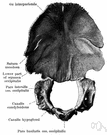squama
Also found in: Thesaurus, Medical, Financial, Encyclopedia, Wikipedia.
squa·ma
(skwā′mə, skwä′-)n. pl. squa·mae (-mē′)
1. A scale or scalelike structure.
2. A thin platelike mass, as of bone.
[Latin squāma.]
American Heritage® Dictionary of the English Language, Fifth Edition. Copyright © 2016 by Houghton Mifflin Harcourt Publishing Company. Published by Houghton Mifflin Harcourt Publishing Company. All rights reserved.
squama
(ˈskweɪmə)n, pl -mae (-miː)
(Biology) biology a scale or scalelike structure
[C18: from Latin]
squamate adj
Collins English Dictionary – Complete and Unabridged, 12th Edition 2014 © HarperCollins Publishers 1991, 1994, 1998, 2000, 2003, 2006, 2007, 2009, 2011, 2014
squa•ma
(ˈskweɪ mə)n., pl. -mae (-mē).
a scale or scalelike part, as of epidermis or bone.
[1700–10; < Latin squāma scale]
Random House Kernerman Webster's College Dictionary, © 2010 K Dictionaries Ltd. Copyright 2005, 1997, 1991 by Random House, Inc. All rights reserved.
ThesaurusAntonymsRelated WordsSynonymsLegend:
Switch to new thesaurus
| Noun | 1. |  squama - a protective structure resembling a scale squama - a protective structure resembling a scalescale - a flattened rigid plate forming part of the body covering of many animals |
Based on WordNet 3.0, Farlex clipart collection. © 2003-2012 Princeton University, Farlex Inc.